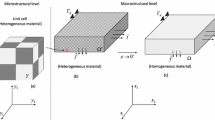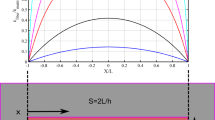Abstract
In this paper three-phase fiber-reinforced matrix is analyzed using analytical micromechanical model named simplified unit cell method (SUCM). The system consists of transversely isotropic elastic nanotube and viscoelastic matrix and interphase region. This interphase region comprises considerable volume fraction of the system because of large surface area per unit volume of the nanotubes. However, volume fraction of the interphase in particular short fiber system is considerably small to contribute to the whole properties of it. The presented closed-form solutions are able to predict the effective response of the three-phase fiber-reinforced matrix in any combination of normal and shear loading conditions. To verify the results, creep compliance of Graphite/Epoxy in 10° and 45° and 90° off-axis conditions are compared with existing data. Nanotube/Polycarbonate is also examined to investigate the effect of interphase on viscoelastic behaviors of nanocomposites.
Similar content being viewed by others
Referances
T. Ramanathan, H. Liu, H. Shen and L. C. Brinson, Functionalized SWNT polymer nanocomposites for dramatic property improvement, Journal of Polymer Science, Part B: Polym. Phys., 43(17) (2005) 2269–2279.
C. Y. Wei, D. Shrivastava and K. Choi, Thermal expansion and diffusion coefficients of carbon nanotube, polymer composites, Nano Lett., 2(6) (2002) 647–650.
Zh. Xi and B. D. Youn, Predictive carbon nanotube models using the eigenvector dimension reduction (EDR) method, Journal of Mechanical Science and Technology, 26(4) (2012) 1089–1097.
Zhimin Xi and Byeng D. Youn, Predictive carbon nanotube models using the eigenvector dimension reduction (EDR) method, Journal of Mechanical Science and Technology, 26(4) (2012) 1089–1097.
A. Ghorbanpour Arani, M. Rahnama Mobarakeh, Sh. Shams and M. Mohammadimehr, The effect of CNT volume fraction on the magneto-thermo-electro-mechanical behavior of smart nanocomposite cylinder, Journal of Mechanical Science and Technology, 26(8) (2012) 2565–2572.
N. Kordani and A. Sadough, Optimization of ethanol content in shear thickening fluid under impact loading, Journal of Mechanical Science and Technology, (2013) Accepted.
E. T. Thostenson and T. W. Chou, On the elastic properties of carbon nanotube-based composites: Modeling and characterization, Journal of PHYSICS D: Applied PHYSICS, 36 (2003) 573–582.
I. C. Finegan, G. G. Tibbetts and R. F. Gibson, Modeling and characterization of damping in carbon nanofiber/polypropylene composites, Composites Science and Technology, 63 (2003) 1629–1635.
H. Liu and L. C. Brinson, A hybrid numerical-analytical method for modeling the viscoelastic properties of polymer nanocomposites, Journal of Applied Mechanics, 73 (2006) 758–767.
F. T. Fisher and L. C. Brinson, Viscoelastic interphase in polymer-matrix composites: Theoretical models and finiteelement analysis, Composite Science and Technology, 61 (2001) 731–748.
PS. Theocaris, The unfolding model for the representation of the mesophase layer in composites, Journal of Applied Polymer Science, 30 (1985) 621–645.
K. Mai, E. Mader and M. Muhle, Interphase Characterization in composites with new non-destructive method, Composites Part A, 29A (1998) 1111–1119.
J. H. HE, H. Y. Kong, R. R. Yang, H. Dou, N. Faraz, L. Wang and C. Feng, Review on fiber morphology obtained by bubble electrospinning and blown bubble spinning, Thermal Science, 16(5) (2012) 1263–1279.
A. Pankonian, Z. Ounaies and C. Yang, Electrospinning of cellulose and SWNT-cellulose nano fibers for smart applications, Journal of Mechanical Science and Technology, 25(10) (2011) 2631–2639.
G. M. Odegard, Modeling and testing of the viscoelastic properties of a graphite nanoplatelet/epoxy composite, Journal of Intelligent Materials and Structures (2005).
S. R. Falahatgar, M. Salehi and M. M. Aghdam, Nonlinear viscoelastic response of unidirectional fiber-reinforced composites in off-axis loading, Journal of Reinforced Plastics and Composites, 28(15) (2009) 1793–1811.
M. M. Aghdam, M. J. Pavier and D. J. Smith, Micromechanical modeling of metal matrix composite subjected combined thermal and shear loading, Proceeding of CADCOMP-98, Montreal (1998) 321–330.
J. Aboudi, A continuum theory for fiber-reinforced elasticvisco-plastic composites, International Journal of Engineering Science, 20 (1982) 605–620.
S. Masoumi, M. Salehi and M. Akhlaghi, Multiscale Analysis of Viscoelastic Laminated Composite Plates Using Generalized Differential Quadrature, Springer-Verlag (2012).
S. R. Falahatgar, M. Salehi and M. M. Aghdam, Micromacro analysis of viscoelastic unidirectional laminated composite plates using DR method, Applied Composite Material, 17 (2010) 427–440.
L. C. Brinson and W. S. Lin, Comparison of micromechanical methods for effective properties of multiphase viscoelastic composites, Composite Structures, 41 (1998) 353–367.
R. N. Yancey and M. J. Pindera, Micromechanical analysis of the creep response of unidirectional composites, ASME Journal of Engineering Materials and Technology, 112 (1990) 157–163.
R. Qiao and L. C. Brinson, Simulation of interphase percolation and gradients in polymer nanocomposites, Composite Science and Technology, 69 (2009) 491–499.
Author information
Authors and Affiliations
Corresponding author
Additional information
Recommended by Associate Editor HYUNG YIL LEE
Manouchehr Salehi completed his B.Sc. (Hons) in Production Engineering in 1984 and M.Phil. in Mechanical Engineering in 1987 at Leeds Metropolitan University and then moved to Lancaster University where he undertook a comprehensive research program on numerical and experimental analysis of stiffened and unstiffened sector plates towards his Ph.D. degree which he completed in 1990. He then returned to his homeland Iran to take up the position of Assistant Professor in Solid Mechanics at the Mechanical Engineering Department, Amirkabir University of Technology, Tehran Iran in 1990. Dr. Salehi is now Associate Professor in Solid Mechanics at the same University. Dr. Salehi has presented more than sixty papers at International and National conferences and has travelled to twelve countries to present these papers. He has more than forty referred journal publications and two books one on’ Optimization of Composite Structures using Genetic Algorithm’ and the other one on’ Engineering Elasticity’.
Rights and permissions
About this article
Cite this article
Fatemifar, F., Salehi, M., Adibipoor, R. et al. Three-phase modeling of viscoelastic nanofiber-reinforced matrix. J Mech Sci Technol 28, 1039–1044 (2014). https://doi.org/10.1007/s12206-013-1177-5
Received:
Revised:
Accepted:
Published:
Issue Date:
DOI: https://doi.org/10.1007/s12206-013-1177-5




